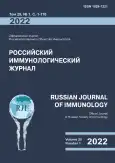Killer cell cluster immunity state in adult patients with common variable immunodeficiency
- Authors: Prokopovich S.S.1, Novikova I.A.1
-
Affiliations:
- Gomel State Medical University
- Issue: Vol 25, No 1 (2022)
- Pages: 93-98
- Section: SHORT COMMUNICATIONS
- URL: https://journals.rcsi.science/1028-7221/article/view/120154
- DOI: https://doi.org/10.46235/1028-7221-1097-KCC
- ID: 120154
Cite item
Full Text
Abstract
The subpopulation spectrum of killer cluster lymphocytes in peripheral blood was assessed by flow cytometry in combination, along with analysis of clinical manifestations in 30 adult patients (12 males and 18 females, mean age 37.5±12.3 years) diagnosed with common variable immunodeficiency (CVID). All the patients were observed at the Department of Immunopathology and Allergology at the State Institution “Republican Scientific and Practical Center of Radiation Medicine and Human Ecology” (Gomel, Republic of Belarus). The diagnosis was based on clinical and laboratory criteria developed by the European Society for Immunodeficiencies, using Common Variable Immunodeficiency Diagnostic Criteria, 2020. The patients were examined in the apparent absence of infectious inflammatory disease, prior to monthly immunoglobulin injections. The control group consisted of 30 healthy subjects, comparable in age and sex with the patients’ cohort, free of clinical and laboratory signs of immunological insufficiency. The patients with CVID had a reduced content of NK cells (CD3-CD16+CD56+) and CD3-CD8+ lymphocytes in peripheral blood (p% = 0.009, rabs = 0.03 and p%, abs < 0.001 respectively), along with increase of T cytotoxic cells and NKT lymphocytes (CD3+CD8+; p% = 0.02, rabs = 0.009 and CD3+CD16+CD56+; p%, < 0.001, rabs = 0.004, respectively). Severe NK cell lymphopenia showed inverse correlation with the numbers of T cyclers (rs% = -0.545, p = 0.03), activated T cytotoxic lymphocytes (CD3+CD8+CD38+; rs% = -0.38, p = 0.04), and directly correlated with CD3-CD8+ cell counts (rs% = 0.481, p = 0.008). We also revealed a correlation between the parameters of killer lymphocyte cluster (CD3-CD16+CD56+, CD3-CD8+, CD3+CD16+CD56+) and severity of clinical manifestations in CVID patients. The most pronounced changes in the killer cell subpopulations were observed in patients with a combined clinical phenotype “infection syndrome + autoimmune syndrome” and “infection syndrome + autoimmune syndrome + enteropathy”. Thus, the marked changes of killer cell subpopulations manifesting as decreased counts of NK cells and CD3-CD8+ lymphocytes, along with increased NKT lymphocytes and T killer numbers are associated with more severe clinical phenotypes of CVID and, above all, with development of autoimmune disorders.
Full Text
##article.viewOnOriginalSite##About the authors
Svetlana S. Prokopovich
Gomel State Medical University
Email: prokopovich.s1983@gmail.com
ORCID iD: 0000-0003-3329-911X
Assistant Professor, Department of Clinical Laboratory Diagnostics, Allergology and Immunology
Belarus, 246038, Gomel, Sviridov str., 61, apt 29I. A. Novikova
Gomel State Medical University
Author for correspondence.
Email: ir-nov@yandex.ru
ORCID iD: 0000-0003-2250-8318
PhD, MD (Medicine), Professor, Head, Department of Clinical Laboratory Diagnostics, Allergology and Immunology
Belarus, 246038, Gomel, Sviridov str., 61, apt 29References
- Новикова И.А., Прокопович С.С., Саливончик А.П., Романива О.А. Клинико-иммунофенотипические аспекты общего вариабельного иммунодефицита у взрослых // Медицинская иммунология, 2022. Т. 24, № 1. С. 195-200. [Novikova I.A., Prokopovich S.S., Salivonchik A.P., Romaniva O.A. Clinical and immunophenotypic aspects of common variable immunodeficiency in adults. Meditsinskaya immunologiya = Medical Immunology (Russia), 2022, Vol. 24, no. 1, pp. 195-200. (In Russ.)] doi: 10.15789/1563-0625-CAI-2185.
- Ameratunga R., Woon S. Perspective: evolving concepts in the diagnosis and understanding of Common Variable Immunodeficiency Disorders (CVID). Clin. Rev. Allergy Immunol., 2020, Vol. 59, no. 1, pp. 109-121.
- Cunningham-Rundles C. Common variable immune deficiency: dissection of the variable. Immunol. Rev., 2019, Vol. 287, no. 1, pp. 145-161.
- Ebbo M., Gerard L., Carpentier S., Vely F., Cypowyj S., Farnarier C., Vince N., Malphettes M., Fieschi C., Oksenhendler E., Schleinitz N., Vivier E. Low circulating natural killer cell counts are associated with severe disease in patients with common variable immunodeficiency. EBioMedicine, 2016, Vol. 6, pp. 222-230
- Linsen L., Somers V., Stinissen P. Immunoregulation of autoimmunity by natural killer T cells. Hum. Immunol., 2005, Vol. 66, no. 12, pp. 1193-1202.
- Mormile I., Punziano A., Riolo C.A., Granata F., Williams M., Paulis A., Spadaro G., Rossi F.W. Common variable immunodeficiency and autoimmune diseases: a retrospective study of 95 adult patients in a single tertiary care center. Front. Immunol., 2021, Vol. 12, 652487. doi: 10.3389/fimmu.2021.652487.
- Tam J., Rautes J. Common variable immunodeficiency. Am. J. Rhinol. Allergy, 2013, Vol. 27, no. 4,pp. 260-265.
- Vankaer L. NKT cells: T lymphocytes with innate effector functions. Curr. Opin. Immunol., 2007, Vol. 19, no. 3, рр. 354-364.
- Wehr C. Trying to understand NK cell function in vivo points towards a Severity Score for CVID Patients. EBioMedicine, 2016, Vol. 6, pp. 18-19.
- Wong G., Huissoon A. T-cell abnormalities in common variable immunodeficiency: the hidden defect. J. Clin. Pathol., 2016, Vol. 69, no. 8, рр. 672-676.
Supplementary files








